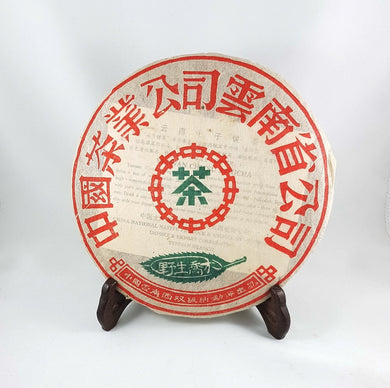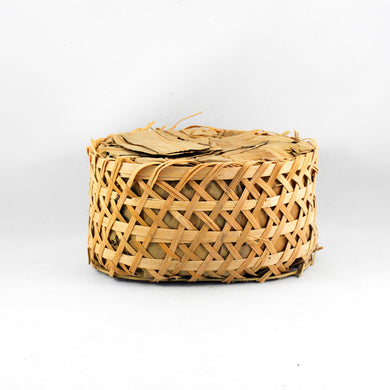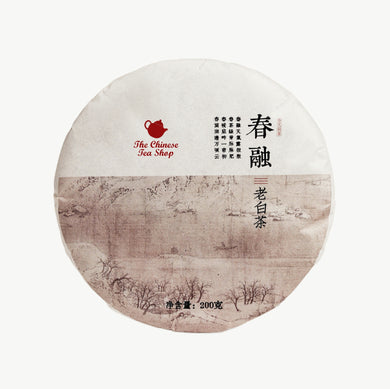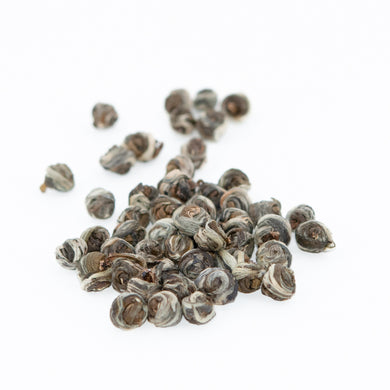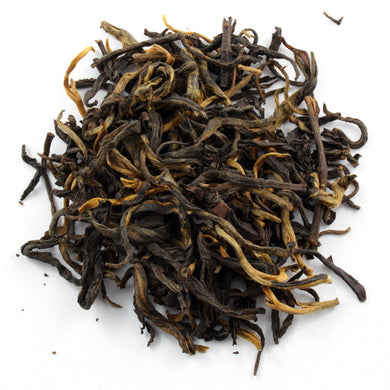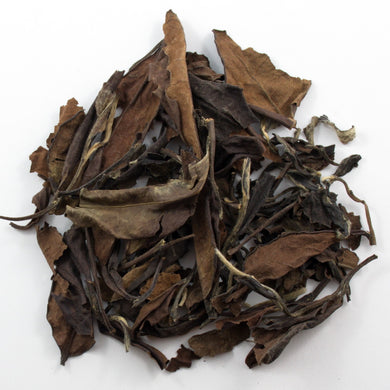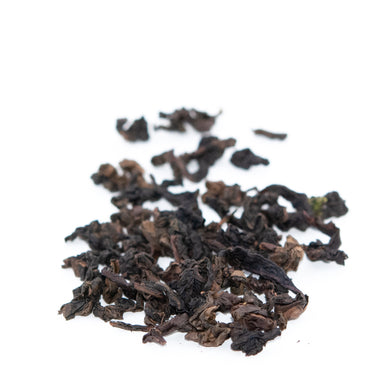1997 Guangxi Liu Bao "Three Cranes" Brand Tea Cake, Guangxi Wuzhou Tea Factory, (Ripe/Shou)

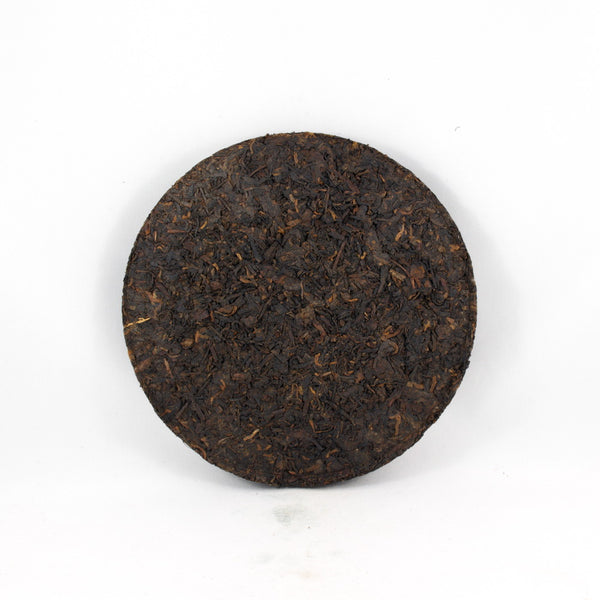

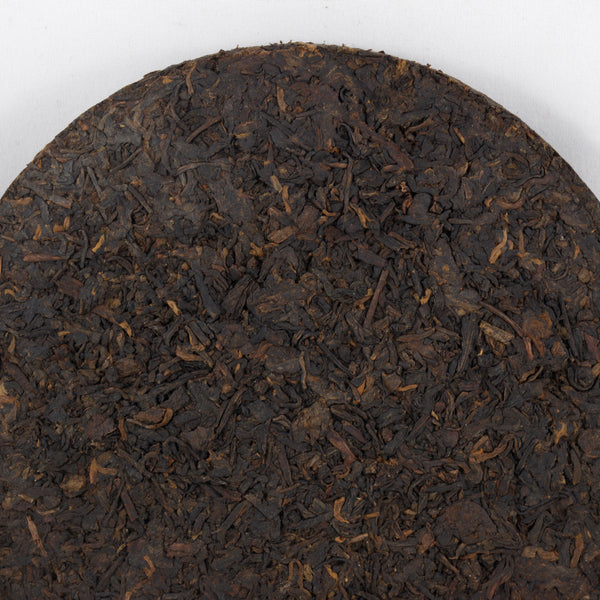
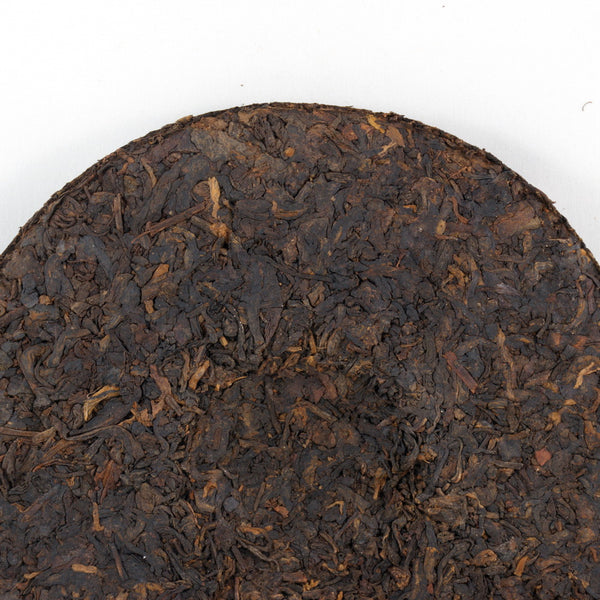
This tea features a dark brown color with robust, thick strands and some tips. The brew is a bright, amber-black. It provides a smooth and refreshing taste, imparting a mild coolness in the mouth, paired with a rich taste that sustains through multiple brews.
The tea's character is marked by an aged woody aroma, subtly sweetened. Drinking it provides a comforting feeling, akin to a warm current flowing through, making it an excellent choice for relaxation, calm, and warmth.
Currently, the tea is in its prime tasting period, and further aging will enhance its flavor, making it even more aromatic over time.
More information of Liu Bao Tea and Guangxi Wuzhou Tea Factory:
Liu Bao tea is named after its place of origin, Liu Bao Town in Cangwu County, Wuzhou. The history of tea production in the Wuzhou area can be traced back over 1500 years to the Northern and Southern Dynasties. During the Qing Dynasty, Liu Bao tea, known for its quality and ability to cool the body and eliminate dampness, was exported to Hong Kong, Macau, and the Southeast Asian countries. Especially in Malaysia, a destination for laborers from Guangdong and Guangxi, became a major market for Liu Bao tea, essential in tin mines and rubber plantations, almost as important as wages.
The Wuzhou Tea Factory's predecessor was established on January 18, 1953, as the "China Tea Industry Company Guangzhou Branch Wuzhou Office Processing Factory." After the establishment of the Guangxi Zhuang Autonomous Region in 1958, it was renamed the Guangxi Zhuang Autonomous Region Wuzhou Tea Factory. In 1990, the trademark Three Cranes "Sanhe" was successfully registered.
Wet piling, a fermentation process, is crucial for developing Liu Bao tea's unique "betel nut aroma." Similar to Fu brick and ripe Pu_erh tea, wet piling involves microbial action and enzymatic processes that promote the natural oxidation of polyphenolic compounds, deepening the tea's color, reducing bitterness, enhancing flavor, and changing the leaf color to reddish-brown. In the mid-1950s, the CNNP ZhongCha Tea Corporation formed a research group focusing on cold water wet piling, with Guangxi specializing in Liu Bao tea. By around 1956, the successful development and application of this technique at the Wuzhou Tea Factory set a precedent for modern wet piling processes. Notably, Liu Bao tea's cold water wet piling technique was documented in 1958, 16 years before the recorded use of a similar process for Pu_erh tea, earning Liu Bao the title "Father of Shou Pu-erh Tea.
Tea: Guangxi Liu Bao "Three Cranes" Brand Tea Cake
Weight Per Cake: 220 grams
Tea Factory: Guangxi Wuzhou Tea Factory
Origin: Guangxi Province
Year: 1997
Types: Post-fermented
The Quick Way - 5 Easy Steps
Step 1
Rinse a teapot, small teacups and a small pitcher with hot water.
Step 2
Put one tablespoon of tea leaves in the teapot for every two people being served. Use more for large leaf tea or for a stronger taste.
Step 3
Place the tea leaves inside the teapot and pour in enough hot water to cover the leaves. Pour out the water immediately to rinse the leaves. Use to this chart for proper water temperatures.
|
Green Tea Silver Needle White Teas and most tea made from “tips” |
75C – 80C |
|
Taiwan Oolong Tips Red/Black Teas |
90C – 95C |
|
Black Teas Pu-Erh (Bow-Lay) Te Guan Yin (Iron Buddha) Da Hong Pao (Cliff Tea) Lapsang Souchong Phoenix Oolong Aged White Teas |
95C – boiling |
IMPORTANT NOTES:
- Too much or too little heat for the tea you are making will break down the leaves too quickly or too slowly and the flavour will be inconsistent. Temperatures can be approximate.
- *Boiling means when the water has just reached a slow boil with big bubbles. The Chinese call this “Fish-Eye Water”. For green tea, watch for small streams of tiny bubbles starting to rise from the bottom of the kettle. This is called “Crab-Eye Water”.
- For Oolong teas, the correct temperature is somewhere between these two. If you do not have a thermometer, let the water stand for 2 minutes or so after reaching a first boil to get 90 – 95C C / 194 – 203 F.
Step 4
Empty the teacups and pitcher. Pour enough hot water into the teapot again to cover the leaves. Wait 8 - 10 seconds and pour the tea into the pitcher and serve, a little longer for a stronger taste. For additional brews, repeat Step 4, deducting two seconds for the second brew and adding two seconds for each additional brew.
Step 5
As the aromatic compounds in the tea leaves dissolve in the water, you will notice the subtle flavours of the tea begin to change with each brew. You will be amazed at the difference! To make tea taste even better, try making tea using Gong Fu Cha method, the traditional Chinese art of tea-making.
The Traditional Way Using The Gong Fu Cha Method
You will need:
- Teapot - preferably a small Chinese Yixing teapot. These have the best heat handling properties for tea-making, as well as for developing the flavour. If you only have a large teapot, use the quantities of water as if a small teapot and tea shown on the charts.
- Small teacups (similar in size to Japanese sake cups) or tiny bowls
- Kettle
- Pitcher - small glass or porcelain
- Fine Strainer - to keep your tea clear and free of sediment
- Tea Tray - A cookie sheet or large flat dish lined with a towel can make a good tray to prepare your tea on.
Step 1 - Warm The Teapot and Pitcher, Sterilize The Teacups and Strainer
The first step is to use the right size of teapot for the number of people you are serving. Most teas taste best when made using a Yixing unglazed clay teapot. Use this chart for the correct size of teapot for the number of people you are serving (use this amount of water if you are using a larger teapot). Pour some hot water into the teapot, pitcher, teacups and over the strainer to rinse, warm and sterilize them.
|
Size of Teapot |
Volume (ml / fl oz) |
Number of People Served |
|
#1 size |
70 / 2.4 |
1 - 2 |
|
#2 |
100 / 3.4 |
2 - 4 |
|
#3 |
175 / 6.0 |
3 - 5 |
|
# 4 |
225 / 7.6 |
4- 6 |
Referring to this chart, determine the correct water temperature for the type of tea you are making. Too much or too little heat will break down the leaves too quickly or too slowly and the flavour will be inconsistent. Temperatures can be approximate.
|
Green Tea Silver Needle White Teas and most tea made from “tips” |
75C – 80C
|
|
Taiwan Oolong Tips Red/Black Teas |
90C – 95C |
|
Black Teas Pu-Erh (Bow-Lay) Te Guan Yin ( Iron Buddha) Da Hong Pao (Cliff Tea) Lapsang Souchong Phoenix Oolong Aged White Teas
|
95C – boiling |
* Boiling means when the water has just reached a slow boil with big bubbles . The Chinese call this “Fish-Eye Water”. For green tea, watch for small streams of tiny bubbles starting to rise from the bottom of the kettle. This is called “Crab-Eye Water”.
For Oolong teas, the correct temperature is somewhere between these two. If you do not have a thermometer, let the water stand for 2 minutes or so after reaching a first boil to get 90 – 97C C / 194 – 206 F.
Step 2 – Rinse The Tea Laves
Empty the teapot and pitcher of the warming water. Place the measured amount of tea into the teapot using this chart and fill with the proper temperature water from the chart above. When pouring water in, allow the water to overflow the top of the teapot until the bubbles disappear and the water runs clear.
|
Size |
Size of Leaves |
|||
|
Rolled Leaves |
Less than 1 cm / 3/8 inches |
1 – 2 cm |
2 - 4 cm |
|
|
#1 size |
0.5 - 1 |
0.5 - 1 |
1 – 1.5 |
1.5– 2 |
|
#2 |
1.5 - 2 |
1.5 - 2 |
2 – 2.5 |
2.5 – 3 |
|
#3 |
3 – 3.5 |
3 – 3.5 |
3.5 – 4 |
4 – 4.5 |
|
# 4 |
4 – 4.5 |
4 – 4.5 |
4.5 – 5 |
5 – 5.5 |
This chart shows the amount of tea to use (in number of tablespoons) based on the size of the tea leaves you are using and the size of teapot. Adjust for personal taste.
Replace the lid and immediately pour off all the water (or a bit longer if using compressed tea) and shake out the last drops. Then tilt the lid slightly open on the teapot. This allows the heat in the teapot to escape and not “cook” the leaves so they can retain their aroma
Step 3 –The First Brew
Fill the teapot until the water flows over the top. Place the lid on the teapot and count the proper number of seconds using this chart. Adjust times to taste.
|
|
Rolled Leaves |
Less than 1 cm / 3/8 inches |
1 – 2 cm |
2 - 4 cm |
|
Rinse the leaves |
4 - 8 seconds |
pour off the tea as quickly as possible |
1- 3 seconds |
2 - 4 seconds |
|
First Brew |
10– 15 seconds |
1 – 2 seconds |
9– 12 seconds |
12 – 15 seconds |
|
Second Brew |
8– 13 seconds |
2– 4 seconds |
8– 10 seconds |
10– 13 seconds |
|
Third Brew |
6– 10 seconds |
4– 6 seconds |
6–8 seconds |
8– 10 seconds |
|
Fourth Brew |
4– 10 seconds |
4– 6 seconds |
6– 8 seconds |
8– 10 seconds |
|
Fifth Brew |
6– 12 seconds |
8– 8 seconds |
8– 10 seconds |
10– 12 seconds |
If you have a tea tray, slowly pour a little hot water over the teapot for a few seconds while counting. At the end of the count, pour the tea into the pitcher and tilt the lid open on the teapot. Empty the teacups of the warming water and serve the tea.
Step 4 – Additional Brews
For the second brew, repeat Step 3 until there is no more flavour from the leaves. High quality tea will make many good tasting brews. The taste of low quality tea will start to fade after only a few brews. Believe it or not, high quality tea is usually less expensive to use in the long run than low quality tea, it tastes better and lasts longer!
If the leaves still have some flavour remaining when you finish, you can keep them in the teapot with the lid closed for up to 12 hours. When you're ready to make more tea, just pick up the timing for the next brew where you left off, less a few seconds.
Congratulations!
Congratulations, you are now ready to move on to a more advanced level of tea-making. For full instructions about Gong Fu Cha, see Gong Fu Cha - The Complete Guide To Making Chinese Tea by Daniel Lui)
Loving my afternoon tea
I thought I ordered again what I ordered my first time, Liu Bao 1992. I am delighted with Three Cranes. Similar to Liu Bao 1992 as I remember. It may be richer. Earthy and very smooth. Thanks.
Excellent experience!
I wanted to try a dark tea and chose this one. Beautiful color. Nice earthy taste. Significant other usually adds sweetener but tried this one without and enjoyed it as I did. Hope to try others in the future as well as keep this one on a go to list. Great service. Thanks.
Great Robust Tea
I keep ordering this because it is a very robust, full bodied tea that has great earthy tones. I sample other teas, but always come back to this one.
Love this tea
I've been buying this tea from the Chinese Tea Shop for about a year and love it. Earthy and strong just the way I like my tea. And you can't beat the prompt and reliable service.
Excellent Tea-Excellent Service
I love this tea. I have tried other teas, but I always come back to this one. Thanks Daniel for your excellent tea selection and your prompt customer service!

You MightAlso Like
$25.95 USD
$42.95 USD
$29.95 USD
$25.95 USD
$20.95 USD
$29.95 USD
$19.95 USD
$26.95 USD
$32.95 USD
$15.95 USD
$14.95 USD
$19.95 USD
$17.95 USD
$39.95 USD
$16.95 USD
$18.95 USD
$22.95 USD
$58.95 USD
$43.95 USD
$21.95 USD


















